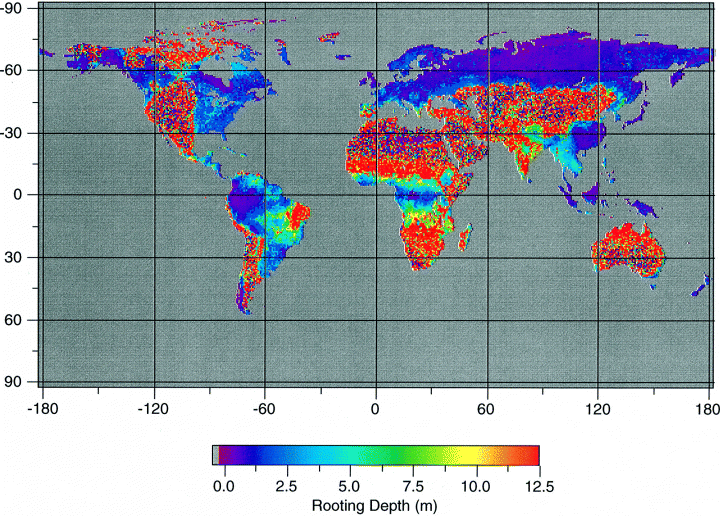Kleidon,A. and Heimann,M.(1998): A
method of determining rooting depth from a terrestrial biosphere
model and its impacts on the global water and carbon cycle.
Global Change Biology, 4, 275-286.
『陸域生物圏モデルから根の深さを決定する方法および世界的な水と炭素の循環に与えるインパクト』
『Abstract
We outline a method of inferring rooting depth from a Terrestrial
Biosphere Model by maximizing the benefit of the vegetation within
the model. This corresponds to the evolutionary principle that
vegetation has adapted to make best use of its local environment.
We demonstrate this method with a simple coupled biosphere/soil
hydrology model and find that deep rooted vegetation is predicted
in most parts of the tropics. Even with a simple model like the
one we use, it is possible to reproduce biome averages of observations
fairly well. By using the optimized rooting depths global Annual
Net Primary Production (and transpiration) increases substantially
compared to a standard rooting depth of one meter, especially
in tropical regions that have a dry season. The decreased river
charge due to the enhanced evaporation complies better with observations.
We also found that the optimization process is primarily driven
by the water deficit/surplus during the dry/wet season for humid
and arid regions, respectively. Climate variability further enhances
rooting depth estimates. In a sensitivity analysis where we simulate
changes in the water use efficiency of the vegetation we find
that vegetation with an optimized rooting depth is less vulnerable
to variations in the forcing. We see the main application of this
method in the modelling communities of land surface schemes of
General Circulation Models and of global Terrestrial Biosphere
Models. We conclude that in these models, the increased soil water
storage is likely to have a significant impact on the simulated
climate and the carbon budget, respectively. Also, effects of
land use change like tropical deforestation are likely to be larger
than previously thought.
Keywords: land use change; net primary production; optimization;
rooting depth; terrestrial biosphere model; water cycle』
『要旨
我々は、陸域生物圏モデルから、このモデル内で植生の利益を最大にすることによって、根の深さを推定する方法を概説する。これは、植生がその局所的な環境を最高限度に利用できるように適合させた進化原理に相当する。我々は単純な生物圏/土壌水文学連結モデルとともにこのモデルを説明し、深い根をもつ植生が熱帯の大部分に存在することが予測されることを見出している。我々が用いているような単純なモデルでさえ、観察される生物群系の標準的な姿をかなりうまく再現することが可能である。最適化した根の深さを用いると、世界的な年間純一次生産(および発散)は1mという根の標準深さの場合と比較して、とくに乾燥期をもつ熱帯地域において、実質的に増加する。蒸発が増すことによる河川流量の減少は、観察結果とうまくあう。我々はまた、最適化された過程は、湿潤および乾燥地域のそれぞれに対する乾季/雨季の間の水の不足/過剰によって主としてもたらされることを見出した。気候変動はさらに根の深さの見積りを大きくする。植生の水利用効率の変化をシミュレートする感度分析で、我々は最適化した根の深さをもつ植生は強制的な変動に弱くないことを見出した。我々は、一般循環モデルおよび世界的な陸域生物圏モデルの地表系の群集をモデル化する場合にこの方法を主に適用することについて調べている。これらのモデルで、土壌水の貯蔵量の増加は、シミュレートした気候および炭素収支のそれぞれに重大な影響を及ぼす見込みがあると、我々は結論づける。また、熱帯森林伐採のような土地利用変化の影響は以前に考えられていたよりも大きくなる恐れがある。』
Introduction
Methodology
Model description
Forcing of the model
Determination of rooting depth
Sensitivity to increased water use efficiency
Results
Optimum rooting depth
Impacts on NPP

Fig. 1 Global distribution of rooting depth obtained from
maximization of NPP. The scattered values in desert ecosystems
is due to the stochastic precipitation generated by a weather
generator.
図1 NPPの最大化から得られた根の深さの世界的分布。砂漠生態系での値のばらつきは、気象発生プログラムにより引き起こされた確率的な降水量のせいである。
〔Kleidon,A. and Heimann,M.(1998): A method
of determining rooting depth from a terrestrial biosphere model
and its impacts on the global water and carbon cycle. Global
Change Biology, 4, 275-286.〕 |
Impacts on watershed hydrology
Mechanism behind the optimization process
Sensitivity to increased water use efficiency
Discussion
Limitations of the model
Net Primary Production
Vertical heterogeneity of soil water distribution/groundwater
Bare soil evaporation
Bedrock/impermeable soil layers
Nutrient uptake
Snow
Frozen soil
Limitations of the method
Equilibrium of vegetation/potential vegetation
Drought-avoidance strategy
Optimal behaviour
Summary and conclusion
References
戻る
